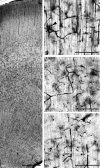The relevance of human fetal subplate zone for developmental neuropathology of neuronal migration disorders and cortical dysplasia
- PMID: 25312583
- PMCID: PMC6495198
- DOI: 10.1111/cns.12333
The relevance of human fetal subplate zone for developmental neuropathology of neuronal migration disorders and cortical dysplasia
Abstract
The human fetal cerebral cortex develops through a series of partially overlapping histogenetic events which occur in transient cellular compartments, such as the subplate zone. The subplate serves as waiting compartment for cortical afferent fibers, the major site of early synaptogenesis and neuronal differentiation and the hub of the transient fetal cortical circuitry. Thus, the subplate has an important but hitherto neglected role in the human fetal cortical connectome. The subplate is also an important compartment for radial and tangential migration of future cortical neurons. We review the diversity of subplate neuronal phenotypes and their involvement in cortical circuitry and discuss the complexity of late neuronal migration through the subplate as well as its potential relevance for pathogenesis of migration disorders and cortical dysplasia. While migratory neurons may become misplaced within the subplate, they can easily survive by being involved in early subplate circuitry; this can enhance their subsequent survival even if they have immature or abnormal physiological activity and misrouted connections and thus survive into adulthood. Thus, better understanding of subplate developmental history and various subsets of its neurons may help to elucidate certain types of neuronal disorders, including those accompanied by epilepsy.
Keywords: Cortical dysplasia; Disorders of neuronal migration; Human fetal connectome; Radial migration; Tangential migration.
© 2014 John Wiley & Sons Ltd.
Conflict of interest statement
The authors declare no conflict of interest.
Figures


References
-
- Kostović I, Judaš M. Prolonged coexistence of transient and permanent circuitry elements in the developing cerebral cortex of fetuses and preterm infants. Dev Med Child Neurol 2006;48:388–393. - PubMed
-
- Kostović I, Judaš M. Transient patterns of cortical lamination during prenatal life: Do they have implications for treatment? Neurosci Biobehav Rev 2007;31:1157–1168. - PubMed
-
- Kostović I, Judaš M. The development of the subplate and thalamocortical connections in the human foetal brain. Acta Paediatr 2010;99:1119–1127. - PubMed
-
- Huang H, Zhang J, Wakana S, et al. White and gray matter development in human fetal, newborn, and pediatric brains. Neuroimage 2006;33:27–38. - PubMed
Publication types
MeSH terms
LinkOut - more resources
Full Text Sources
Other Literature Sources

